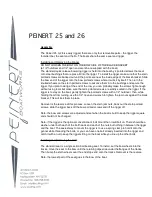
5-9
Galvanic
Galvanic corrosion (electrolysis) can result in
serious damage to any metal component of your
Cobalt boat that is in the water. Galvanic corrosion
is the deterioration of metals due to the effects of
electrolytic action. When dissimilar metals are
immersed in a conductive fluid such as salt water,
an electric current is produced, similar to the
action of a battery. The softest of the metals will
be the first to become damaged.
Galvanic corrosion can occur in fresh or salt
water, however, salt, brackish and polluted waters
accelerate galvanic corrosion.
A self-sacrificing anode can be mounted to your
Cobalt boat to help prevent damage to metal
components from galvanic corrosion. The anode
will require frequent inspections. If the anode
shows deterioration of 50% or more, it must be
replaced for continued protection.
NOTICE: Refer to the propulsion unit
operator’s manual for their
requirements for galvanic corrosion
protection.
Salt Water
Wash the entire boat after each use in salt water.
If you continue to operate in salt water, the entire
boat should be protected against salt water
damage as described in
Interior/Exterior Care
, in
this section.
Refer to the propulsion unit operator’s manual for
manufacturer’s salt water operating
recommendations.
Marine Growth
If marine growth is a problem in your boating
area, it may be necessary to apply anti-fouling
paint to the hull to slow growth and prevent
gelcoat damage. Consult your Cobalt dealer for
recommendations.
CAUTION
Do not paint an anode, its fasteners or its
mounting surface. Painting will reduce the
anode’s corrosion protection capabilities.
LIFTING THE BOAT
To prevent structural damage to your Cobalt
Performance Cruiser, the proper procedure must
be used when lifting your boat. Only use
appropriate style lifting slings to lift the boat.
Using Lifting Eyes
Your Cobalt boat is not equipped with lifting eyes.
Slings must be used to lift the boat.
Using Lifting Slings
The only recommended method of removing the
boat from the water is to use lifting slings. Slings
must be the flat, wide belting-type. Do not use
cable-type slings. The spreader bars used with the
slings must be long enough to avoid pressure to
the gunwales.
Two sling location decals on each side of the hull
indicate the general area where each sling should
be located. Slings may need to be adjusted
forward or aft of the decals for your particular
boat.
1. Sling tag location
2. Flat, wide-belting sling
Storage Cradle
Only use a storage cradle to store your boat when
it’s not in the water. A storage cradle will provide
proper support and prevent stress on the hull.
Position the storage cradle as close to the sling
tag locations as possible. Use caution not to
damage any underwater fittings.
The storage cradle must completely touch the hull
for proper support. Avoid any gaps between the
cradle and the hull.
2
1
1
COB065C
Troubleshooting and Maintenance
Содержание 360
Страница 1: ...Owner s Manual ...
Страница 36: ...2 22 ...
Страница 74: ...3 38 ...
Страница 108: ...5 14 ...
Страница 111: ...6 3 SERVICE LOG Date Hour Reading Service Repairs Performed Checklist Forms and Index ...
Страница 112: ...6 4 FUEL LOG Date Gallons Hours Gallons Hour Date Gallons Hours Gallons Hour ...
Страница 118: ...6 10 ...
Страница 119: ......
















































